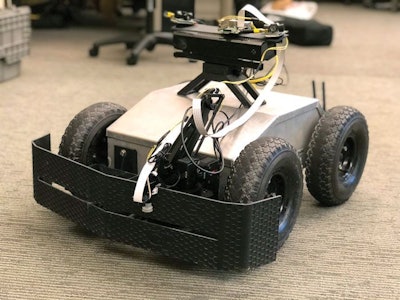
Commercial broiler chicken houses have thousands of birds that need to be checked daily to ensure good management practices. Research scientist Colin Usher with Georgia Tech Research Institute's Food Processing Technologies Division presented information about using robotics for poultry house management as part of WATT Global Media’s inaugural Poultry Tech Summit in Atlanta.
The robot is intended to help commercial operations assess equipment, remove floor eggs, recognize mortality and give a qualitative analysis of birds and the environment. This product has potential to minimize labor needs, employee turnover and help biosecurity practices by mitigating cross-contamination from human entrance. “Our goal is to create a robot that can do everything a farmer needs to do in a house,” Usher said.
Over the last couple of years, the cost of robotics has come down substantially. “There probably isn’t a farmer out there that is going to spend $60,000 to put a robot in their chicken houses; it just doesn’t make any sense,” he said. Usher anticipates the smart robot will not cost $30,000 dollars. “It hopefully hits a price point that is attractive to farmers,” he said.

Usher did testing to determine what impact the robot would have on the birds' well-being. He concluded that robot interaction is not detrimental to the birds' well-being and that the system had no trouble moving around various sized birds. | Georgia Tech Research Institute
Drastic price changes have made it possible for researchers to look at these novel technologies as a possibility in places where they didn’t economically make sense before.
Usher started his work in robotics with a feasibility study using manually controlled robots that operate on the floor of the poultry house and can move in the litter. His thought process was, if a system can’t move through the birds manually, then why spend the money to automate it? He concluded that robot interaction is not detrimental to a chicken’s well-being, and the system had no trouble moving around various sizes of birds.
The smart robot system
Every element of the system is an off-the-shelf component, he explained, except for the bumper and some wiring that was 3-D printed for the project. The robot steers like a skid steer loader and not as an automobile does.
So far the system has been tested in various litter conditions and hasn’t experienced any issues.
“This system is designed to be able to sense the environment, understand the environment and be able to navigate its way through it,” Usher said. He explained that the robot isn’t very loud and is typically drowned out by other noises in the house.
Smart robot capabilities
The machine’s capabilities include mapping and navigation, executed searches, a robotic arm for manipulation and it can be remote controlled.
The smart robot uses a localization system containing sensors that tell the robot where it can go. It is also equipped with Marvelmind indoor GPS, which allows the robot to know exactly where it is in the poultry house, within 2 centimeters.
The robot remembers where it has been and does execute searches. This is important for picking up eggs or removing mortality. “If there is a place in the house where the robot can’t get to because chickens are not moving, it can go on and search the rest of the house and then come back to that area,” Usher explained.
The robotic arm uses a suction cup to pick up the eggs. However, Usher explained more work is needed for the removal of mortality due to bird weight and picking them up.
If the system was adapted for a turkey housing system, it would have to be made at a larger scale to handle the mortalities.
The smart robot’s remote control capability allows farmers to pull the device up on their phone and use a 360-degree camera to look around the house. They can also drive the robot, so in instances where the operator wants to check something specific, he can. “When the operator is done, the robot goes back and continues its autonomist plan,” Usher said.
The machine is also capable of environmental sensing for humidity, floor moisture, temperature, light levels and gasses such as ammonia, carbon dioxide, methane and others. It has vision-based sensing which allows it to do classification and segmentation, along with welfare monitoring.
The smart robot also has a deep neural network detection system, which allows it to detect objects like eggs, chickens, feeders and drinkers. It can also compute locations of 3-D objects so it knows where to pick up eggs with its robotic arm.
The robot sleeps on its charging station when it’s not navigating the house.
Robots in the cattle industry
Cargill recently took an off-the-shelf robot and redesigned it to drive cattle in the holding pens at processing plants. The redesign was done in hopes of minimizing the number of employees who would have to work with what can be dangerous cattle. This robot is operated manually and allows management to move cattle without being close enough to risk any harm.
According to Cargill, the robotic cattle driver costs up to $50,000. The robot has a tough metal exterior and options for customization depending on the needs of the operation. An MP3 player can relay recordings of whistles to help drive animals forward, according to a recent National Public Radio report (NPR).
Robotics are becoming increasingly common in dairy and feedlot operations, in part because the work is dangerous, and finding workers to fill jobs is challenging, according to David Douphrate, an expert in agricultural worker safety at the University of Texas, who was referenced in the NPR report.
Innovations to change poultry production: www.WATTAgNet.com/articles/36187

















